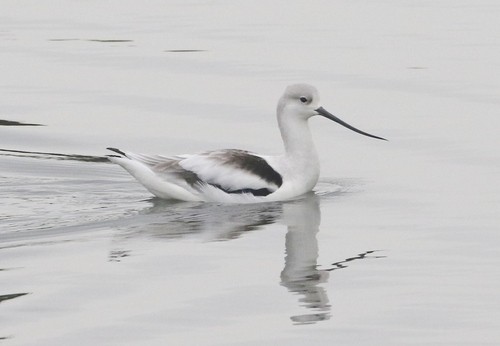American Avocet
A species of Avocets Scientific name : Recurvirostra americana Genus : Avocets
American Avocet, A species of Avocets
Botanical name: Recurvirostra americana
Genus: Avocets
Content
Description People often ask General Info
 Photo By silversea_starsong , used under CC-BY-NC-4.0 /Cropped and compressed from original
Photo By silversea_starsong , used under CC-BY-NC-4.0 /Cropped and compressed from original Description
The American avocet measures 40–51 cm (16–20 in) in length, has a wingspan of 68–76 cm (27–30 in) and weighs 275–420 g (9.7–14.8 oz) The bill is black, pointed, and curved slightly upwards towards the tip. It is long, surpassing twice the length of the avocet's small, rounded head. Like many waders, the avocet has long, slender legs and slightly webbed feet. The legs are a pastel grey-blue, giving it its colloquial name, blue shanks. The plumage is black and white on the back, with white on the underbelly. During the breeding season, the plumage is brassy orange on the head and neck, continuing somewhat down to the breast. After the breeding season, these bright feathers are swapped out for white and grey ones. The avocet commonly preens its feathers - this is considered to be a comfort movement. 
Size
46-51 cm (18-20 in)
Colors
Black
Yellow
Bronze
White
Orange
Life Expectancy
9 years
Nest Placement
Ground
Clutch Size
3 - 4 eggs
Incubation Period
1 brood
Number of Broods
18 - 30 days
Feeding Habits
American Avocet forage in shallow waters using scything, pecking, and plunging to consume aquatic invertebrates, small fish, and plant seeds. They adaptively switch between tactile and visual feeding methods, with a preference for brine shrimp in winter and brine flies during breeding. Foraging varies by time and flock size.
Habitat
American Avocet predominantly inhabit open wetlands such as marshes, mudflats, and shallow lakes. They show a preference for saline environments but are also found in freshwaters. Breeding sites typically feature sparse vegetation, ideal for nesting near or just east of the Rocky Mountains at low to moderate altitudes. In winter, american Avocet frequent coastal habitats like intertidal zones, brackish waters, and adjacent agricultural areas. They are adaptable to human-made environments such as evaporation ponds and salt pans throughout the western and southern United States, as well as localized regions in Mexico.
Nest Behavior
Male and female american Avocet collaboratively choose the nesting site and both may contribute to creating and lining the scrape. Nest building adjusts to environmental changes.
Nest Characteristics
The american Avocet constructs ground nests on islands or dikes, preferring spots with sparse vegetation. The nest is a shallow scrape lined with grass, feathers, pebbles, or left unlined; it may be fortified against flooding during incubation.
Dite type
Aquatic invertebrate eater
People often ask
General Info
Feeding Habits
Bird food type
Sounds
Call
Recording location: United States
Behavior
American Avocet engage in a variety of distinctive behaviors that highlight their adaptability to their wetland habitat. During daily activities, american Avocet can be seen wading through shallows or swimming in deeper waters in search of food. They exhibit a highly social aspect, breeding in loose colonies and diligently defending their territories with unique threat displays. Intruders are met with a mix of postures and movements, including crouch-runs and an intriguing tightrope-like gait with wings outstretched. American Avocet's complex mating rituals involve elaborate pre-copulation displays with frenzied splashing, followed by neck intertwining and synchronized running with their mates. Additionally, the 'circling' display, involving multiple birds, underscores their intricate social interactions. In winter, american Avocet exhibit flocking behavior, often associating with other shorebird species, demonstrating a harmonious integration within their ecosystem.
Distribution Area
American avocets were previously found across most of the United States until extirpated from the East Coast. The breeding habitat consists of marshes, beaches, prairie ponds, and shallow lakes in the mid-west, as far north as southern Canada. These breeding grounds are largely in areas just east of the rocky mountains including parts of Alberta, Saskatchewan, Montana, Idaho, Washington, Utah, North and South Dakota, Nebraska, Colorado, and even down to parts of New Mexico, Oklahoma and Texas. Their migration route lands them in almost every state in the western United States. The avocet's wintering grounds are mainly coastal. Along the Atlantic Ocean, they are found in North and South Carolina, Georgia and Florida. There are also wintering grounds along the Gulf of Mexico in Florida, Texas, and Mexico, and along the Pacific Ocean in California and Mexico. There are resident populations in the Mexican States of Zacatecas, San Luis Potosí, Guanajuato, Hidalgo, Mexico City and Puebla, and in Central California. 
Species Status
Not globally threatened.
Scientific Classification
Phylum
Chordates Class
Birds Order
Shorebirds Family
Stilts and avocets Genus
Avocets Species
American Avocet